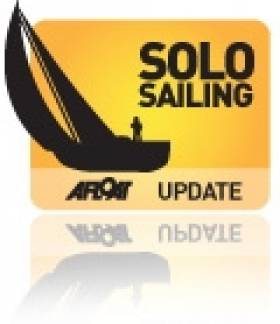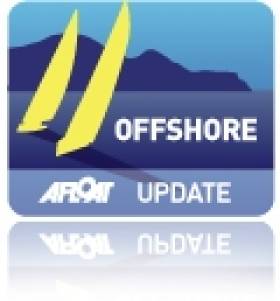Displaying items by tag: Robin Knox Johnston
50 Entrants from 17 Countries for Golden Globe Race
#solosailor – Today marks the 46th anniversary of Sir Robin Knox-Johnston's departure from Falmouth UK back in 1968 to become the first person to sail singlehanded non-stop around the world. Of the 9 starters in that Sunday Times Golden Globe Race, Robin and his 32ft ketch rigged yacht Suhaili were the sole finishers.
Six weeks after announcing a second Golden Globe race to mark the 50th anniversary of that remarkable feat, the race organisers have received 50 serious expressions of interest from sailors in17 countries – Australia, Austria, Bermuda, Brazil, Britain, Canada, France, Germany, India, Italy, New Zealand, Norway, South Africa, Spain, Sweden, USA and Russia.
"The response has been remarkable" says Don McIntyre, adding. "The concept for a retro race in long-keeled monohulls like Suhaili and sailing round the world with nothing more than the equipment that was available to Robin 5 decades ago, has obviously hit a chord with many people."
McIntyre has received a further 150 letters from people asking for more information. The Race is limited to 30 competitors and the first names will be published on August 1st. Entries close on 31st December 2015.
The 2018 Golden Globe Race is very simple. Depart Falmouth, England on 14th June 2018, sail solo, non-stop around the world via the five Great Capes and return to Falmouth. Entrants are restricted to using the same type of yachts and equipment that were available to Sir Robin in that first race. That means sailing without modern technology or benefit of satellite based navigation aids. Competitors must sail in production boats between 32ft and 36ft overall (9.75 – 10.97m) designed prior to 1988 with a traditional full-length keel with rudder attached to their trailing edge, similar in concept to Knox-Johnston's Suhaili.
Pre-Notice of Race
The Pre-Notice of Race has now been published and lists the 32-36ft long-keeled production boats approved for the race with the addition of Suhaili replicas known as 'ERIC' designs built in wood, steel or fibreglass. The course has also been amended to include additional 'gates' in the Canary Islands, Cape Verde Islands and Falkland Islands for competitors to drop off film, and a southern boundary of 47°S in the Southern Ocean has been set after Kerguelen Island to keep the fleet clear of icebergs.
In addition, prior to the Race, entrants are now required to sail for one day under jury rig made up of two spinnaker poles and an emergency rudder system, and carry all this equipment during the race.
While no digital or satellite technology is allowed, for safety reasons, competitors will be issued with a satellite phone, and tracking system through which they can send two 100 character text messages a day directly to the race organisers. All other communications have to be made via HF radio, just as Sir Robin Knox-Johnston used during the 1968/9 Sunday Times Golden Globe Race.
For further information go to www.goldengloberace.com
#routedurhum – It has been a dramatic night with 15 incidents across the classes, including a collision between an Ultime trimaran and a cargo ship, the air rescue of a sailor after his boat lost its keel and overturned, and a Multi50 sailor who is awaiting help after his float broke off.
Thomas Coville saw his hopes of winning the Route Du Rhum vanish during the first night of the trans-Atlantic race when he damaged his yacht in a collision with a cargo ship.
Competing in the Ultimate class, the skipper of Sodebo Ultime escaped uninjured but damaged the starboard float on his boat.
Coville, who won the 3,542-nautical mile (6,560-kilometer) leg between Saint-Malo and the French Caribbean island of Guadeloupe in 1998 in the monohull class, was among the favorites for this year's race.
Another French skipper, François Angoulvant, had to be rescued after his Class 40 Team Sabrosa lost its keel. Angoulvant was airlifted to Brest where he is in good condition, according to race organisers.
Loick Peyron was leading the field early Monday aboard Banque Populaire VII.
Clipper Race chairman and founder, Sir Robin Knox-Johnston, has sent his first blog since he started Transatlantic solo race, the Route du Rhum - Destination Guadeloupe yesterday at 1400 CET from Saint-Malo, France.
With winds of 30 knots plus and large seas reported overnight, Sir Robin sent this report from his Open 60, Grey Power, this morning.
A grey sea, overcast, light drizzle and a West South Wester'ly Force 5 greeted me at dawn this morning. I am currently 40 miles from Ushant and debating whether to take the inner side of the Traffic Separation zone. Currently making 6-7 knots. Could do more if I put up more sail but we'll stay like this for the time being, as the wind is still 20 plus knots and gusting higher, just had one of 29 knots and the sea very lumpy.
It's a long race, and no point in breaking things at the beginning. I made a very cautious start. My Clipper Race colleague Simon Johnston was with me until half an hour before when my Rhum class competitor Bob Escoffier sent his rib to take him ashore. He has been invaluable, as was fellow colleague Alex Dower.
I soon found myself surrounded by 40's most of yesterday evening, pushing hard. Those boats are quick, but when the forecast squalls of 40 knots arrived I would not have wanted to be in one. Fortunately I had decided to settle in on the first night, so already had 3 reefs in the main and the storm jib set, but the boat was still pushed hard over and even with the mainsail pushed right down its track, was crashing into the waves.
I saw a couple of Automatic Identification Scheme targets turn round, I think they were in the race, but it was a gear breaking situation if you did not think of the boat and try to get her comfortable. We came through without damage, except for the staysail sheets becoming amorous, and it took a dark, cold wet hour on the foredeck, often under water, sorting out the resulting snakes' honeymoon.
Now typing this on a jumping boat is far from easy, as the computer often skips a letter or inserts one you did not ask for.
I am wondering how the big multis are fairing and if everyone is alright. There was some mention on Channel 16 last night but it was in fast spoken French.
C'est tout pour le moment.
RKJ






























































